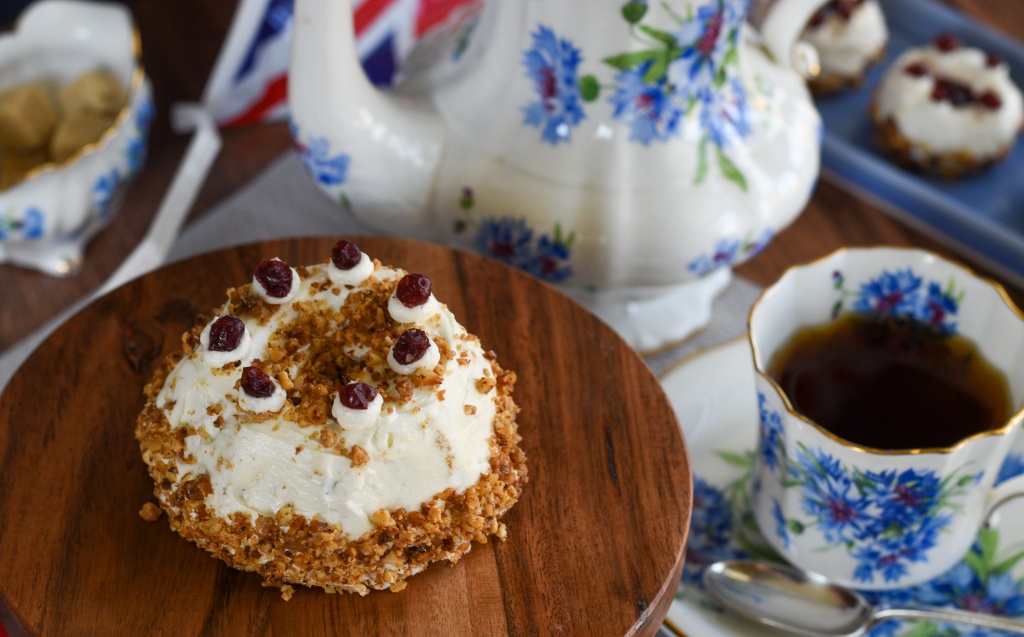Well, I just can’t let the occasion of a royal coronation pass me by without recognizing it in cake somehow! (Personally, as significant, and full of pomp and circumstance a coronation is, isn’t it really all about the food?! Coronation recipes are already flying around the internet, I see.)
With the Windsor family’s strong links to Germany, I thought preparing my version of a Frankfurter Kranz would be totally appropriate. Even aside from the fact that the name and look of the cake is meant to be remind one of a bejeweled crown. Kranz is the word for wreath, or crown, and with the round shape of it, and the lingonberries (or cherries in a more traditional version) representing rubies, it seemed like the one to make, as the land of (at least some of) my ancestors gets a new King.

I’ll just say up front that I have not rewritten and reposted the recipe for this one in this post, but I will link to it, so you can check it out for yourselves: It’s the Dr. Oetker recipe here.
This version is called a “Classic Frankfurter Kranz”, though I used to make this recipe 20+ years ago from the Backvergnügen Wie Noch Nie recipe book I got when I lived in Germany and the recipe is different. That is to say, the look, flavors, way it’s prepared – that’s all basically the same. But the sponge recipe certainly deviates from the one I’m used to; and the frosting in my old favorite doesn’t use pudding, as this one does!
When I check out a few others posted on the internet, there’s variations to them as well, so I’m not sure if there’s actually one “classic”! If I’m honest, I’ll go back to the one in my 30-year old recipe book next time – it just used to turn out better for me.
That being said, the Dr. Oetker recipe had its high points – the sponge was pretty good, quite airy, maybe not quite as tender (probably because it had more egg than my other recipe; also less flour and no cornstarch, like the other). I did miss the hint of citrus and rum in this one as well, which I think makes the sponge a little more interesting.

I also found that when I used the vanilla pudding in the buttercream, the buttercream just broke for me. So ultimately I couldn’t use it, and just switched to an American buttercream to be able to frost and fill these small-to-mini-versions of this cake.
To be fair, I didn’t have Dr. Oetker vanilla pudding, just used an American brand. So there may be something in those mixes that doesn’t work to make a buttercream frosting, I’m not quite sure.

To the third component of the cake – the Krokant, I can only say “wow! where have you been all my life?!”. The Dr. Oetker direction on how to make this was perfect – it only takes three ingredients and worked exactly as the recipe described. I used hazelnuts instead of almonds, but that’s the only thing I did differently.
And not only is this a hallmark of a Frankfurter Kranz cake, it really adds a nice crunch and flavor. I will definitely be saving my leftovers for future cakes! They would make a great extra crunch between cake layers as well.
Below is what the “brittle” looks like just off the stove and cooling on parchment; then finely chopped in a small grinder to make it the right size for garnishing the outside of the cake.


So, per usual, I went for smaller-sized cakes, though if I’m honest here again, I probably wouldn’t do that again! It’s a LOT more difficult to frost them as they get smaller, and it does make such an impressive regular-sized cake, I’d probably just stick with that instead.
For the small ones (as opposed to “mini”), I used the NordicWare Geo Bundtlette because it happened to be the only one I had in this approximate size (~3.5 inches diameter). This was large enough to get one layer with filling (though some recipes only fill with buttercream and no jam). And it works great to serve in small slices with an afternoon tea where you have other delectables as well.


For the mini-sized cakelets, I went with the Wilton doughnut pan, which strictly speaking isn’t a bundt! but got me to the mini size. With this size, I couldn’t make any layers, so I frosted as best I could and put a squirt of the cherry jam into the middle (which wasn’t really a hole, as it was filled with frosting).


As to the decoration – a normal Kranz would have Krokant all over it, but I opted to put it around the bottom, and then sometimes sprinkle it more lightly all over.
Also, instead of using cherries (sour or maraschino) which were too big for these sized cakes, I used small lingonberries instead (from a lingonberry jam I had; you could just use lingonberry jam as well).
So this is quite a long post without an actual recipe! but I hope these thoughts and guidance gives you the courage to try this amazing German cake – whether for the coronation or your own special afternoon tea!
